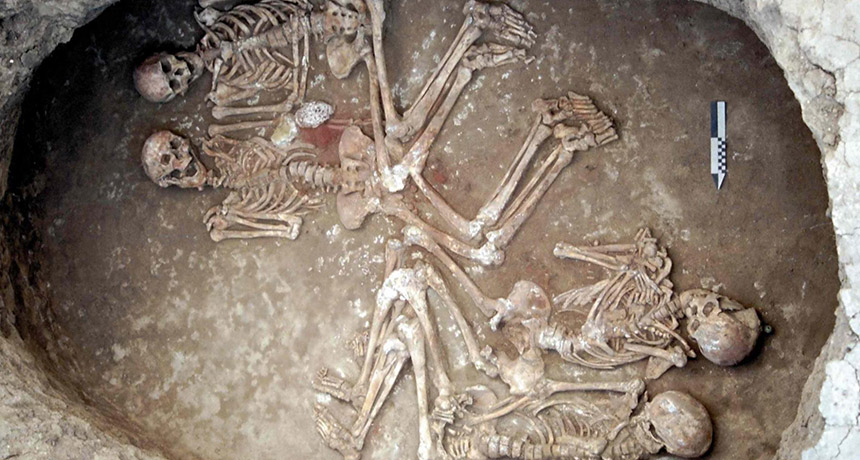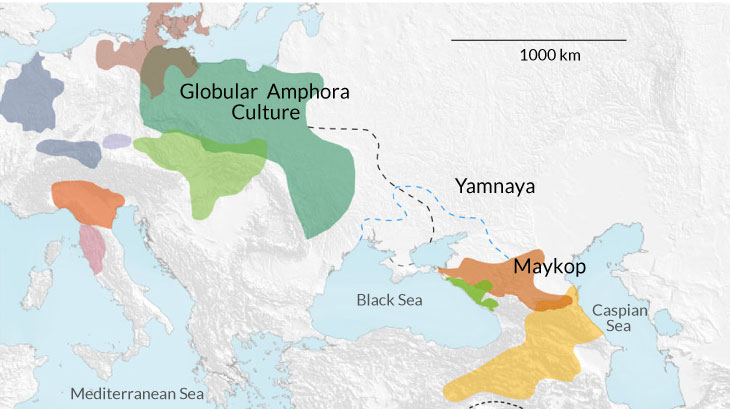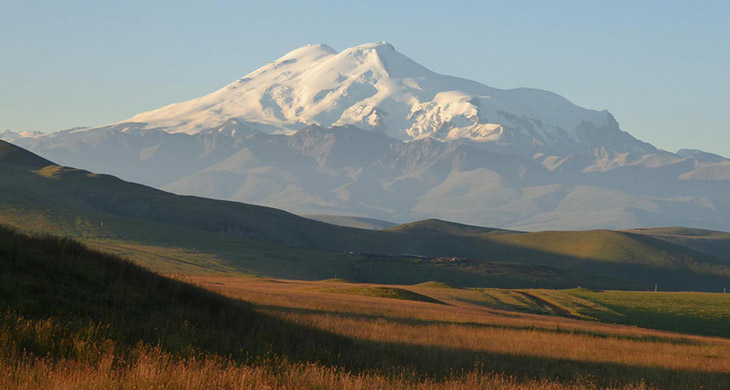DNA reveals early mating between Asian herders and European farmers
The finding might rewrite the origins and spread of key cultural innovations and languages

FIRST STEPPES Yamnaya herders from western Asia, four of whom are buried in this grave, started mating with European farmers hundreds of years before launching a major migration into Europe, new DNA evidence indicates.
A. Kalmykov
Hundreds of years before changing the genetic face of Bronze Age Europeans, herders based in western Asia’s steppe grasslands were already mingling and occasionally mating with nearby farmers in southeastern Europe.
That surprising finding, published online February 4 in Nature Communications, raises novel questions about a pivotal time when widespread foraging and farming populations interacted in Eurasia’s Caucasus region. Those exchanges presumably sparked the geographic spread of metalworking, the wheel and wagon, and Indo-European languages still spoken in much of the world.
Archaeologists have often assumed that, as early as around 5,600 years ago, Caucasus farmers known as the Maykop migrated north in big numbers, bringing metalworking and early Indo-European tongues to herders who roamed grasslands on the edge of the region. In that scenario, this cultural exchange led steppe herders to develop a horse-and-wagon lifestyle that the nomads later transported to Europe and Asia, along with Indo-European languages, starting about 5,000 years ago (SN: 11/25/17, p. 16). Researchers call those mobile herders Yamnaya people.
Genetic ties
An ancient DNA analysis unexpectedly found signs of mating more than 5,000 years ago between western Asian Yamnaya herders and European farmers, possibly from the Globular Amphora Culture. In another surprise, Maykop farmers thought by many researchers to have dramatically influenced Yamnaya culture left no genetic mark on the herders. The dotted lines represent the suspected spheres of influence exercised by the Globular Amphora Culture and the Maykop people in Yamnaya territory.
The possible intersection of three ancient cultures more than 5,000 years ago

But in an unexpected twist, Yamnaya DNA shows signs of a shared ancestry only with eastern European farmers, not the Maykop people. The genetic analysis, led by population geneticist Chuan-Chao Wang of Xiamen University in China and molecular anthropologist Wolfgang Haak of the Max Planck Institute for the Science of Human History in Jena, Germany, provides the best look to date at Yamnaya herders’ genetic history.
The scientists analyzed sets of inherited alterations in the DNA of 45 individuals, including four Yamnaya and 12 Maykop, excavated from Caucasus and steppe graves dating to between 6,500 and 3,500 years ago. Comparisons were made to previously extracted DNA from other ancient Europeans, Asians and Native Americans.
A majority of Yamnaya ancestry came from Caucasus-based hunter-gatherers and a minority of Yamnaya ancestry — between 10 and 18 percent — was inherited from eastern European farmers, the scientists estimate. Those farmers may have belonged to Europe’s more than 5,000-year-old Globular Amphora Culture, named for its globe-shaped pottery.
These results indicate that, well before Yamnaya herders made a big-time move to Europe, “there was a sphere of interaction in eastern Europe between people of otherwise very different genetic backgrounds,” Haak says.
Maykop people, on the other hand, inherited about half of their DNA from Anatolian farmers, who inhabited what’s now Turkey, Haak and his colleagues report. That finding further underscores the genetic separation of Maykop farmers from Yamnaya herders, who don’t share any DNA with Anatolian cultivators.

Migrations of some Maykop into Yamnaya territory, accompanied by the transfer of knowledge and language, still happened, Wang’s team suspects. Occasional migrations north through the Caucasus to Yamnaya grasslands fits a scenario in which the ancient homeland of Indo-European language lay among Anatolian farmers, the researchers speculate. If they’re right, they have resolved one of the thorniest issues in the study of languages. But the long-debated origins of Indo-European tongues remain uncertain.
Maykop people excavated in Yamnaya territory came from a small, isolated population that shows no signs of herder ancestry, contends archaeologist David Anthony of Hartwick College in Oneonta, N.Y. “It just emphasizes that Maykop people chose not to mate with Yamnaya or pre-Yamnaya people.”
Without regular marriages across the two cultures, Maykop people would not have transferred their language to the Yamnaya, Anthony contends. He considers it likely that Indo-European precursor languages originated among steppe herders.






